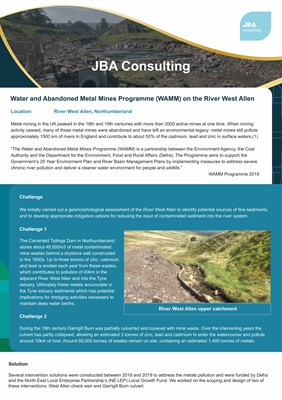
JBA Consulting
We initially carried out a geomorphological assessment of the River West Allen to identify potential sources of fine sediments,
and to develop appropriate mitigation options for reducing the input of contaminated sediment into the river system.
Metal mining in the UK peaked in the 18th and 19th centuries with more than 2000 active mines at one time. When mining
activity ceased, many of these metal mines were abandoned and have left an environmental legacy: metal mines still pollute
approximately 1500 km of rivers in England and contribute to about 50% of the cadmium, lead and zinc in surface waters.(1)
"The Water and Abandoned Metal Mines Programme (WAMM) is a partnership between the Environment Agency, the Coal
Authority and the Department for the Environment, Food and Rural Affairs (Defra). The Programme aims to support the
Government's 25 Year Environment Plan and River Basin Management Plans by implementing measures to address severe
chronic river pollution and deliver a cleaner water environment for people and wildlife."
WAMM Programme 2019
Water and Abandoned Metal Mines Programme (WAMM) on the River West Allen
Location: River West Allen, Northumberland
Solution
Several intervention solutions were constructed between 2018 and 2019 to address the metals pollution and were funded by Defra
and the North East Local Enterprise Partnership's (NE LEP) Local Growth Fund. We worked on the scoping and design of two of
these interventions: West Allen check weir and Garrigill Burn culvert.
Challenge 1
The Carrshield Tailings Dam in Northumberland
stores about 48,000m3 of metal contaminated
mine wastes behind a drystone wall constructed
in the 1800s. Up to three tonnes of zinc, cadmium
and lead is eroded each year from these wastes,
which contributes to pollution of 40km in the
adjacent River West Allen and into the Tyne
estuary. Ultimately these metals accumulate in
the Tyne estuary sediments which has potential
implications for dredging activities necessary to
maintain deep water berths.
Challenge 2
During the 19th century Garrigill Burn was partially culverted and covered with mine waste. Over the intervening years the
culvert has partly collapsed, allowing an estimated 3 tonnes of zinc, lead and cadmium to enter the watercourse and pollute
around 10km of river. Around 60,000 tonnes of wastes remain on site, containing an estimated 1,400 tonnes of metals.
River West Allen upper catchment
Challenge